Snakes have always held a certain bit of a mystifying air about them and you never know the kind of reaction you’ll get from someone when you tell them that you own a snake. You see them as pets a lot and when you do, they’re almost always going to be small.
Sometimes though, people that are reptile or snake enthusiasts want to step it up a level and get a large snake, something that will have people in awe, one that can be shown off. This is where the white-lipped python can come into play. They hail from Papua New Guinea and the Indonesia Islands.
While only two types of white-lipped pythons will be discussed, the northern and southern, it is thought by herpetologists that there are as many as six different kinds of species that exist in the wild.
Most white-lipped pythons that people get are imported and bred on snake farms in Indonesia. There are few that actually breed them in captivity. Some snakes are even caught in the wild and then sold as pets! These are the most difficult to tame and will most likely have their aggressive and defensive nature for life.
Because of this, it is always good to know where you are getting your snake from and that it is from a reputable vendor.
If you are an experienced reptile owner and love snakes, the white-lipped python might be the pet for you. Not for the faint of heart, these snakes can grow to be 6-7 feet long. Hence the experienced snake owner warned.
This article can help you decide for yourself whether or not you are prepared to undertake the responsibilities of such an animal for a pet.
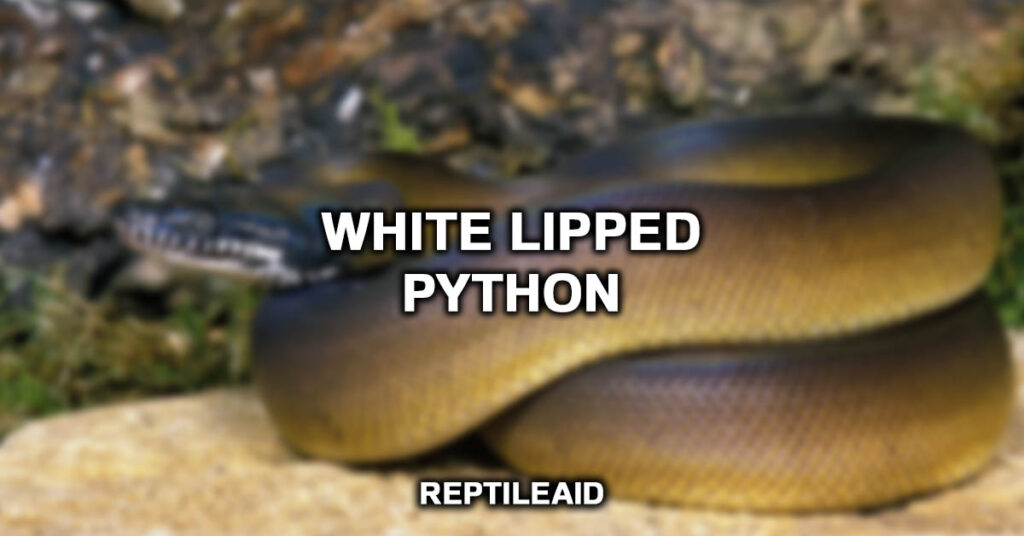
Do White-Lipped Pythons make good pets?
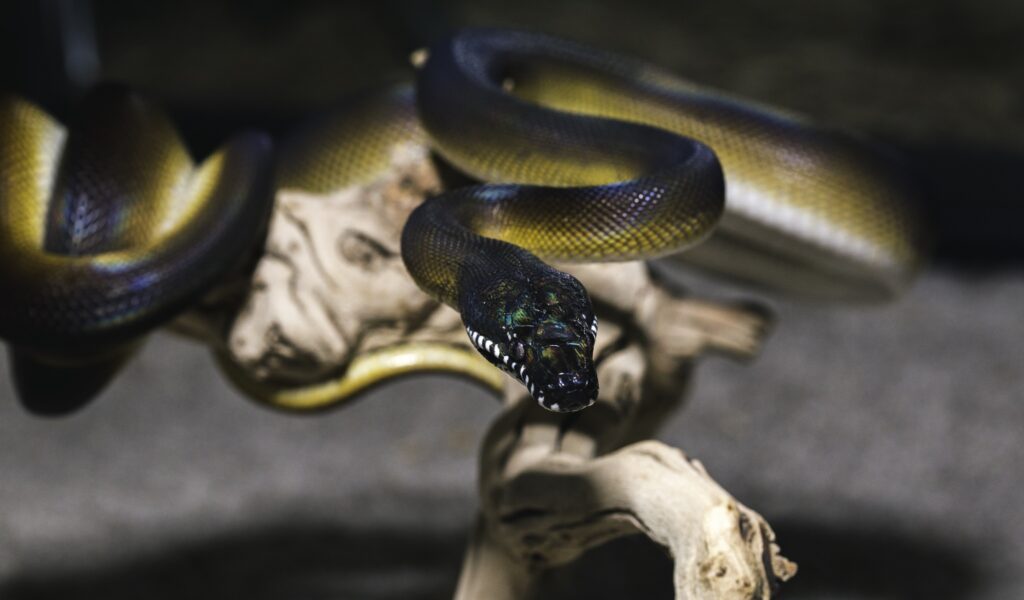
Before knowing whether a white-lipped python would make a good pet for you. You must ask yourselves some questions; are you prepared for their longevity? When well taken care of, these magnificent animals can live up to 30 years. That is quite the time commitment and if you’re even slightly hesitant about that kind of lifespan, then it’s best that you do a hard pass.
If you’re looking for a pet that you can snuggle up with then this snake is a hard pass as well. They are temperamental, nippy, and defensive in nature, so building up their trust is a priority. There is good news however, captive breeding has begun to breed out the aggressive nature of the snake more or less, albeit it is still going to be there.
So, when you have a snake with this temperament paired with how big it can get (6-7 feet) you might be asking for trouble. Even the most experienced snake owners are still recommended to get a snake hook when taking it out of its enclosure since they are most likely to strike at you when inside their enclosure.
If you are dead set on getting one, remember that handling is essential to taming them! If any of this sounds off-putting, then you already have your answer of whether or not a white-lipped python would be for you. If you like a challenge and this sounds exciting, then definitely read on!
The different appearances of the White-Lipped Python
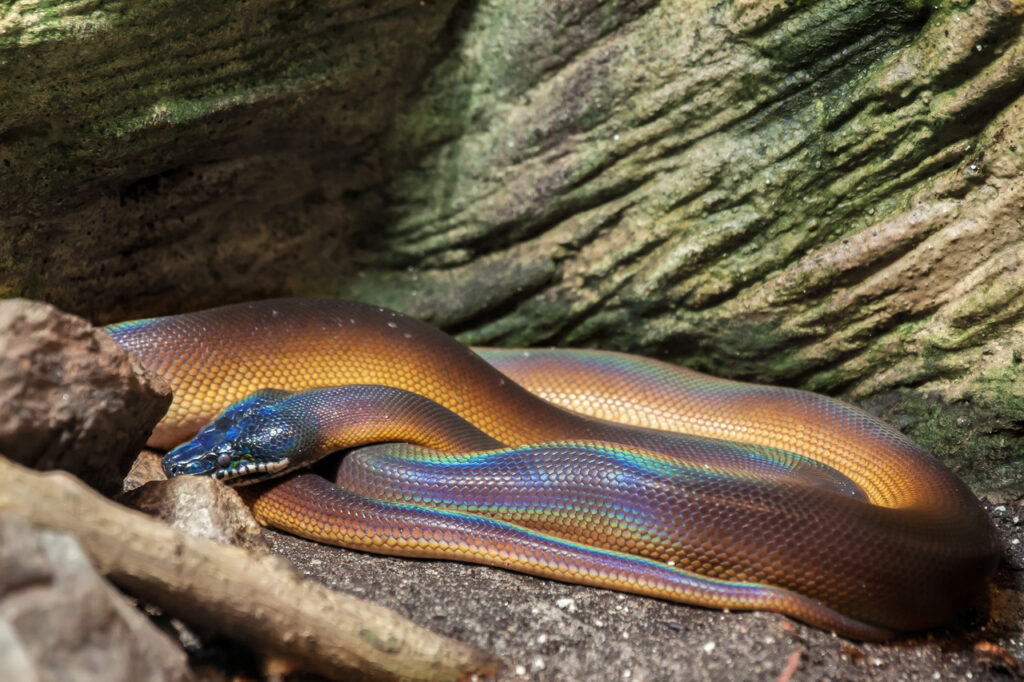
The white-lipped python is a beautiful creature with two different distinctive types that people will keep as pets; the northern white-lipped python and the southern white-lipped python. The northern python has a dark brown-black head and body with a contrasting cream underbelly.
On the other hand, the southern white-lipped python is a less vibrant color with a gray coloring that is lighter on the sides, this one also has a cream underbelly. Around their mouths are white scales which is where their name comes from that are similar in appearance to little teeth.
For either snake type, however, when the light catches on the snake’s scales, it is suddenly a beautiful iridescent color. This is one of the things this breed is most commonly known for (other than its aggressive nature).
Habitat care for your White-Lipped Python
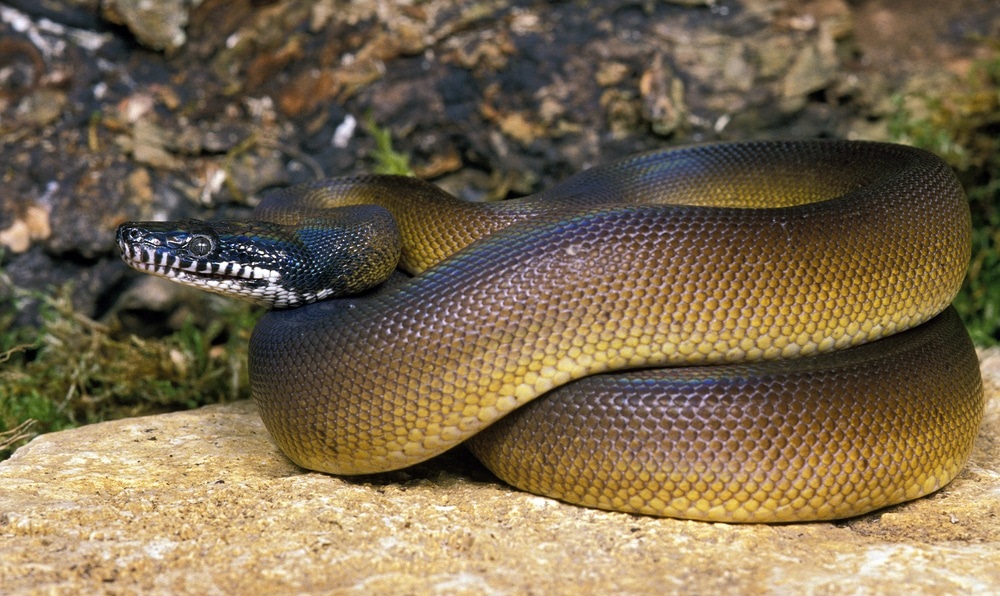
Now how does one care for these huge snakes? It’s not as easy as if you had a small corn snake that’s for sure. While a 4x3x2 tank size is a good starting point, it is actually recommended to get an even larger tank which is understandable seeing as how large this python can get.
A deep clean of the entire tank is recommended once a month, but as with anything there might need to be some small spot cleaning done in between. It is important to keep in mind to avoid direct sun exposure for your snake. This can cause it to overheat and die. A heat lamp’ kept at 95 degrees Fahrenheit is good while keeping the tank itself at 85 degrees Fahrenheit.
Be sure to never let the enclosure get below 75 degrees Fahrenheit (even during the night)! This can cause unwanted health issues that could have easily been avoided. The best substrate for your snake is a mixture of coconut bark, organic topsoil, and cypress mulch this is because they can hold humidity well which is what your snake needs.
Lastly, humidity is key. The humidity should be kept between 75%-90% and be misted daily. It is important to remember that the enclosure must especially be humid for when they shed as this makes the process easier for them.
Although you want the substrate damp, make sure it never gets swampy, muddy, or watery as this can lead to mold growth and scale rot (see more on that below under “Caring for Your White-Lipped Python”).
Expert Tip: Be aware that since the python is so active and very excitable, there is a strong chance that the water dish will be overturned a lot. Pay close attention to this as too much spillage can lead to a dangerously wet substrate.
While the white-lipped python is known to be semi-arboreal in the wild. This means that much of their life is spent on the ground, but will climb a tree if it means eating something tasty.
Overall, they are very active snakes, specifically known as crepuscular, which means they are most active in the late afternoon to twilight hours, so the more climbing spots and hiding places the more fun for them to explore!
“Please note that white-lipped pythons are sensitive to humidity it is best to avoid using a lamp if possible since this can dry out the tank as well as the python. Instead, opt for using a heating pad or heat tape to regulate their temperature.”
Feeding Your White-Lipped Python
In the wild, the white-lipped python’s diet consists of whatever small mammals it can find as well as small birds, however in captivity they can live on a diet of thawed and/or freshly killed mice and rats like other snakes. For your juvenile python (0-12 months old) feed them mice every 5-7 days. As an adult, they can be fed one rat every 10-14 days.
If you see your python cough up a hairball of the animal they ate. do not be alarmed. This is common for the white-lipped python. When they are shedding be sure not to feed the snake as they are at their most vulnerable and the rodent may even kill them.
Your python won’t be in the mood to eat anyway. Live prey is not recommended for the captive white-lipped python due to its thin skin. If you would like to spice up their diet every once in a while, adding a guinea pig, a young rabbit, a small chicken, or a quail is always s a tasty treat!
Caring For Your White-Lipped Python: health issues and what to look for
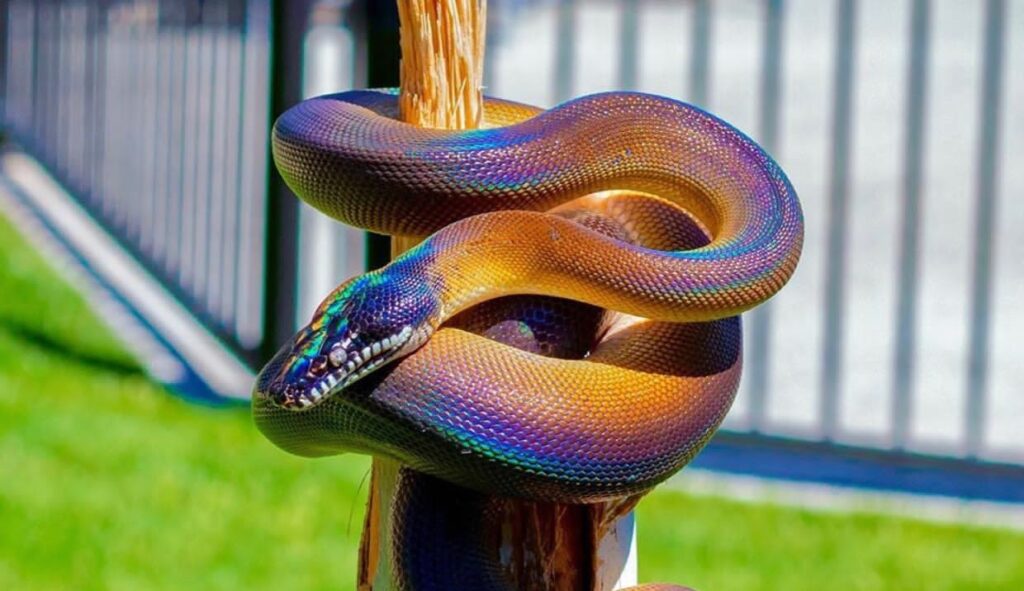
As mentioned above these snakes can live for a long time so be prepared for a commitment! 30 years if well taken care of.
Like any animal, the white-lipped python comes with its own risk of health issues it can run into parasites (such as mites), scale rot, respiratory infections, and obesity. These health issues are all easily avoidable or easily treated if caught in time as well as preventable.
For example, most of the time an obese snake means that you’re feeding it too much, so it’s safe to say that cutting back on its diet can help.
A mite infestation can happen if the habitat is not cleaned enough, you can notice mites when you see the snake soaking itself more than usual and can even see the dead mites in the water.
While it is important the habitat is humid, this means that one also must be careful of scale rot, damaged scales on the snake’s underbelly, and sides that are tinged with brown and very thin.
This would be easy to see on the cream-colored underbelly of a white-lipped python. It is imperative that small climbing trees are put into the habitat for the snake to climb on to dry itself off.
Since snakes only have one functioning lung, any respiratory infection must be seen as life-threatening and taken care of by a vet as soon as possible.
They can get a respiratory infection from a dirty cage (again it’s important to do a deep clean of it once a month and clean any messes you see in between), stress, cold temperatures (don’t let that temperature drop below 75) and excessively high or low humidity.
Expert Tip: Signs to look for if your snake has a respiratory infection are a rattling or crackling sound when it’s breathing, breathing through an open mouth, and excessive discharge coming from the nostrils and/or mouth.
It is important to note that like any snake, the white-lipped python is an exotic animal. Because of this, it is best to find an exotic pet veterinarian to care for your pet if it becomes sick.
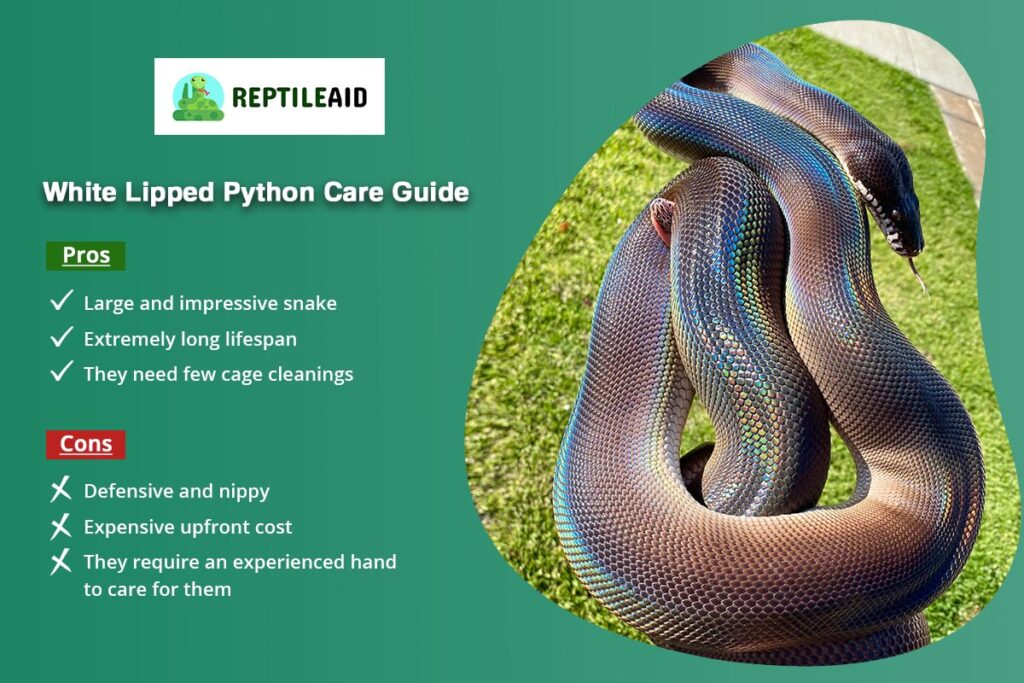
In Conclusion
While an extraordinary and one-of-a-kind pet to show off, it is important to know that these are not your regular snakes. A lot of consideration must go into the thought of getting one of these animals. Something not commonly thought of is what if you go out of town or on a vacation?
Who will be taking care of your snake? As mentioned multiple times above, this snake is for experienced owners. If someone is hesitant to watch it for you. don’t let them. If you have to travel a lot for work, this might not be the snake for you.
Keep in mind how long these snakes can live, they are a lifelong commitment. If you don’t think you can take care of something for so long, it’s probably best to look elsewhere for a pet. It is also important to remember how temperamental these snakes can be. Are you alright with risking getting bit?
If you are an inexperienced snake owner then it’s best to wait until you have more experience. I would say to use a ball python as a step up, however, they are too docile to be compared to that the white-lipped python. If you are experienced, then this snake could be for you.
Something to remember is that there is no might get bit, you most likely will get bit in the beginning. Again, this is why handling them cannot be stressed enough. Until that trust is built it is not the best idea to let friends that come over handle the snake as well. During the time of building trust, it is better for you the snake, and others if it is observed and not handled.
They seem easy to care for but it is their attitude that leaves little to be desired. As mentioned multiple times now, that is why handling is a must.
After reading this, do you feel more informed about the white-lipped python? Would you want one as a pet or do you already have one and can or want to share more knowledge? Be sure to post a comment in the section below! Don’t be shy about posting pictures of them as well if you own one!
Overall, if you are an experienced snake owner then I recommend taking on the challenge of having the white-lipped python as a pet. This is not a breed for first-time snake owners.
